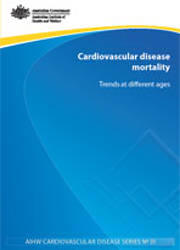Cardiovascular disease mortality: trends at different ages
Citation
AIHW
Australian Institute of Health and Welfare (2010) Cardiovascular disease mortality: trends at different ages, AIHW, Australian Government, accessed 18 April 2024.
APA
Australian Institute of Health and Welfare. (2010). Cardiovascular disease mortality: trends at different ages. Canberra: AIHW.
MLA
Australian Institute of Health and Welfare. Cardiovascular disease mortality: trends at different ages. AIHW, 2010.
Vancouver
Australian Institute of Health and Welfare. Cardiovascular disease mortality: trends at different ages. Canberra: AIHW; 2010.
Harvard
Australian Institute of Health and Welfare 2010, Cardiovascular disease mortality: trends at different ages, AIHW, Canberra.
PDF | 552Kb
Despite a dramatic reduction since the late 1960s, cardiovascular disease remains the largest cause of death in Australia. Cardiovascular disease mortality: trends at different ages examines recent data to determine if the observed decrease in cardiovascular disease deaths since the 1960s is shared across disease sub-types and among different population groups. This report includes information on the past and recent trends of key cardiovascular diseases such as coronary heart disease and stroke, and describes how trends vary on the basis of age group and sex. International trends are also presented for comparison. The analyses presented in this report help to better understand what is driving the observed decrease in cardiovascular disease deaths, and are a useful resource for policy makers, researchers and health professionals interested in cardiovascular diseases.
- ISSN: 1323-9236
- ISBN: 978-1-74249-000-7
- Cat. no: CVD 47
- Pages: 93
-
Death rates for total cardiovascular disease and each of its component diseases all fell between 1987 and 2006
-
The annual decline in death rates for heart failure/cardiomyopathy has been accelerating
-
For coronary heart disease (CHD) and stroke recent declines have been greatest among people aged 55-74 years
-
The annual decline in rheumatic fever and rheumatic heart disease has been smaller than for CHD and stroke



